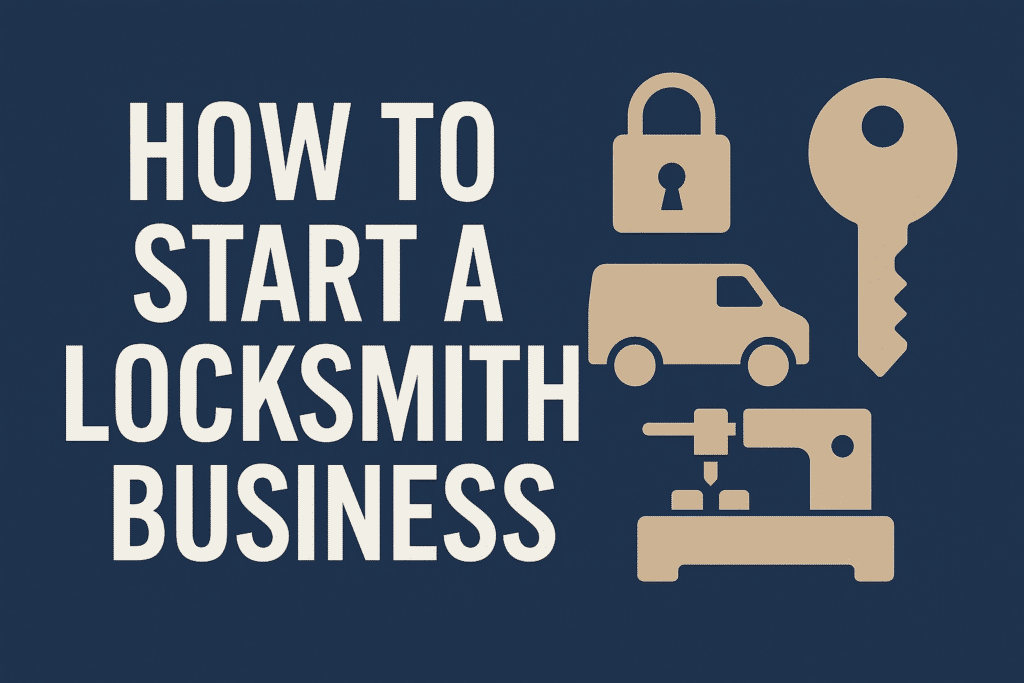
Table of Contents
The locksmith industry may not be flashy, but it’s a stable and essential service in every community. If you have the technical know-how and are ready to take charge of your career, learning how to start a locksmith business can be your ticket to financial independence and professional fulfillment.
According to IBISWorld, the U.S. locksmith industry is valued at over $2 billion annually, with steady demand for residential, commercial, and automotive services. With the rise in smart locks and security systems, skilled locksmiths are more relevant than ever.
This comprehensive guide walks you through each critical step of building a locksmith business—from training and licensing to marketing and client retention. Let’s break down the blueprint for launching your own successful locksmith operation.
1. Understand What the Locksmith Business Involves
Before jumping in, understand what being a locksmith entails. Locksmiths handle:
- Residential lockouts and installations
- Automotive key replacements and reprogramming
- Commercial security system setups
- Safe installations and combinations
- Emergency 24/7 services
Each category may require slightly different training and tools. Specializing in a niche (e.g., automotive or high-security locks) can increase your revenue and reduce competition.
2. Get Certified and Trained
Certification isn’t just a formality—it builds trust. In many states, locksmiths must complete approved training and pass a background check before getting licensed.
Recommended Certifications:
- Associated Locksmiths of America (ALOA) offers well-recognized certifications like Certified Registered Locksmith (CRL) and Certified Automotive Locksmith (CAL).
- State-specific programs (e.g., California’s Bureau of Security and Investigative Services)
Hands-On Training:
- Attend trade schools or community college programs
- Take online courses supplemented with in-person workshops
- Seek apprenticeships with established locksmiths
Tip: Even in states without licensing requirements, being certified adds legitimacy and justifies premium pricing.
3. Register and Legally Structure Your Business
Choose Your Business Structure:
- Sole proprietorship – Simple, minimal paperwork
- LLC – Protects personal assets, preferred for liability reasons
- Corporation – Suitable for scaling or large teams
Register Your Business:
- Pick a unique business name (make sure the domain is available)
- Register with your state’s Secretary of State office
- Apply for an EIN (Employer Identification Number) via IRS.gov
- Acquire any required business licenses (local or state)
Pro tip: Some cities require a separate locksmith license—check with your municipality.
4. Meet Licensing and Insurance Requirements
Locksmithing is a trust-based industry, so regulations are tight in some states. You may need:
- Locksmith license (required in states like TX, CA, IL, NJ)
- Background check/fingerprinting
- Surety bond (common in regulated states)
Insurance Essentials:
- General Liability Insurance – Protects you from lawsuits
- Commercial Auto Insurance – If using a company vehicle
- Tools & Equipment Insurance – Covers lost or damaged tools
- Workers’ Comp – If hiring employees
5. Invest in Locksmith Tools and Equipment
Starting strong means having the right gear. Here’s a list of must-have tools:
- Lock pick sets
- Key cutters and duplicators
- Tension wrenches
- Slim jims and bump keys (for auto work)
- Code cutting machines
- Diagnostic software (for electronic and smart locks)
- Key programming tools (OBD programmers for automotive locksmithing)
Initial Tool Investment:
Expect to spend $2,000 to $10,000, depending on your specialty.
6. Develop a Financial and Startup Plan
Creating a locksmith business requires strategic budgeting.
Startup Costs Breakdown:
| Expense | Estimated Cost |
|---|---|
| Training & Certification | $500 – $3,000 |
| Licensing & Legal Fees | $300 – $1,200 |
| Tools & Equipment | $2,000 – $10,000 |
| Van or Work Vehicle | $5,000 – $25,000 (new or used) |
| Website & Branding | $500 – $2,000 |
| Marketing | $500+ initially |
| Insurance | $600 – $2,500 annually |
Tip: Consider mobile locksmithing first to avoid renting a storefront.
7. Build a Brand and Launch Your Website
A professional image makes all the difference.
Branding Checklist:
- Business name + domain
- Logo and color palette
- Uniforms with logo
- Branded vehicle wrap
Website Essentials:
- Mobile-friendly design
- Service pages optimized for local SEO
- Online booking or inquiry form
- Google Maps integration
- Reviews/testimonials page
SEO Tip: Integrate the keyword “how to start a locksmith business” subtly into your blog posts and service descriptions to attract aspiring locksmiths or B2B clients.
8. Offer a Range of Locksmith Services
Diversifying your services maximizes your earning potential. Here are popular revenue streams:
- Residential and commercial lockouts
- Rekeying services
- Automotive transponder key programming
- Smart lock installations
- Safe opening and installation
- Emergency 24/7 services (premium pricing opportunity)
Pro tip: 24/7 availability or rapid-response service can give you a competitive edge.
9. Master Local and Digital Marketing
No matter how skilled you are, clients need to find you. Here’s how to market smartly:
Local SEO and Online Presence:
- Register on Google Business Profile
- List your business on directories: Yelp, Angi, Thumbtack
- Encourage satisfied clients to leave reviews
- Use geo-targeted keywords like “locksmith in [city name]”
Digital Ads:
- Run Google Ads for emergency locksmith terms
- Use Facebook/Instagram ads targeting local zip codes
Offline Marketing:
- Branded magnets, flyers, and business cards
- Partner with property managers, realtors, and car dealerships
- Offer referral discounts
10. Use Technology to Run Your Business Efficiently
Leverage tech tools to stay organized and competitive.
Recommended Software:
- Jobber or Housecall Pro – Schedule jobs and manage invoices
- QuickBooks – For accounting and taxes
- CRM software – Manage client history and communications
- GPS tracking – Optimize dispatch and route planning
- Mobile payment processors – Accept card payments on-site
11. Build Relationships and Network for Growth
Success often comes from who you know.
Networking Tips:
- Join trade associations like ALOA
- Attend local chamber of commerce events
- Build partnerships with local auto dealers, landlords, and property managers
- Ask for Google reviews after each job
Long-term strategy: Consider training apprentices and expanding into a multi-van operation once you’re established.
12. Prepare for Challenges and Plan for Longevity
Every business has its obstacles. Here are a few to anticipate:
- Emergency burnout – 24/7 services are demanding
- High competition – Especially in urban areas
- Trust-building – Clients are cautious with security professionals
- Technology shifts – Smart locks and automation demand continuous learning
Stay updated with industry trends and never stop refining your skills.
Final Thoughts: Turning Skill into Success
Starting a locksmith business is not just about cutting keys—it’s about unlocking a secure, independent future.
With the right training, a solid marketing strategy, and a commitment to professionalism, you can build a thriving operation that provides valuable services and financial stability.
Remember: every big business starts with a single decision. So, if you’ve been wondering how to start a locksmith business, the time to take action is now.
Read more:
What Must an Entrepreneur Do After Creating a Business Plan?
How to Start a Car Detailing Business?
